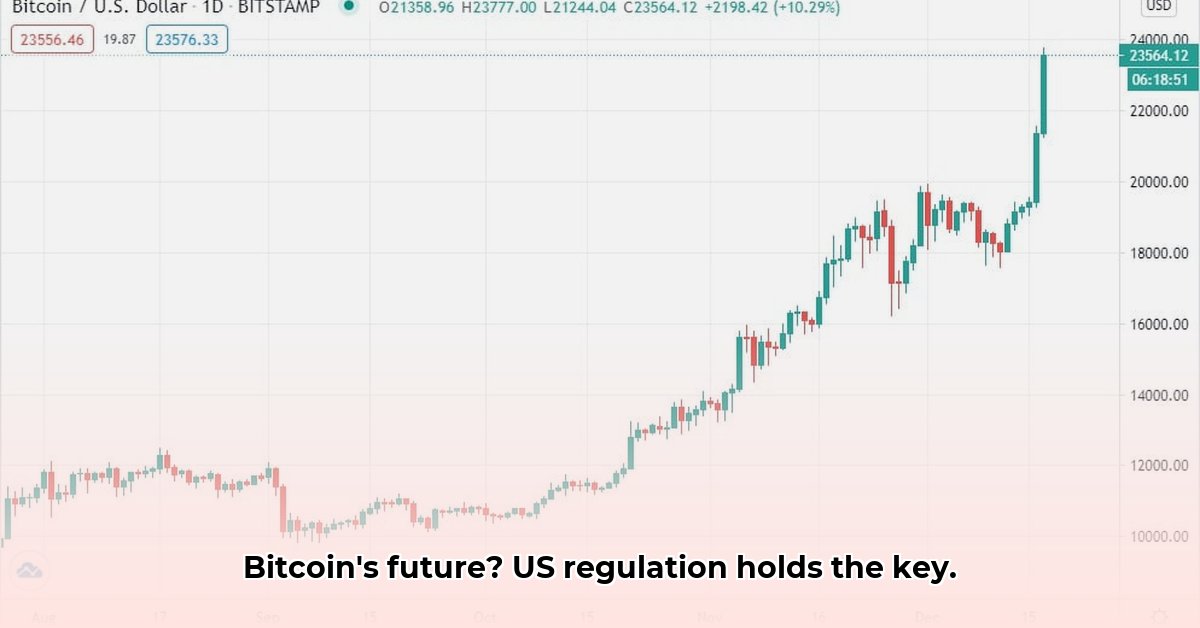
Bitcoin USD Exchange Rate Analysis: Decoding the Price Volatility
Bitcoin's price, denominated in US dollars, exhibits significant volatility, influenced by a complex interplay of global events and evolving cryptocurrency regulations. Recent examples, such as Pakistan's reported consideration of Bitcoin for its national reserves, highlight the profound impact of governmental actions. However, the absence of a clearly defined regulatory framework in the United States, a pivotal global economic player, contributes significantly to market uncertainty and price fluctuations. This regulatory ambiguity acts as a major catalyst shaping the unpredictable nature of Bitcoin's value. For deeper insights into Bitcoin's price fluctuations, see this in-depth analysis.
The Regulatory Tightrope Walk: Balancing Innovation and Oversight
The current regulatory landscape presents a delicate balancing act. Excessive regulation risks stifling innovation and hindering the growth of the cryptocurrency market. Conversely, insufficient regulation increases vulnerabilities to illicit activities, including money laundering and terrorist financing. Striking the right balance between these competing forces is crucial and directly influences Bitcoin's USD exchange rate. This ongoing tension between regulatory oversight and market freedom significantly shapes the market dynamics.
Is the current regulatory environment conducive to sustainable growth in the cryptocurrency market? The answer remains elusive, with the constant tug-of-war between regulatory bodies and market forces leading to price volatility. This uncertainty creates both opportunities and risks for investors.
Beyond Regulations: Fundamental Value and Market Dynamics
Bitcoin's price movements aren't solely driven by regulatory developments. Bitcoin's characteristics as a scarce digital asset, often compared to "digital gold," contribute to its underlying value. This intrinsic value, independent of short-term price fluctuations, plays a crucial role in determining long-term price trends. Understanding this fundamental aspect is vital for interpreting price movements correctly. The narrative surrounding Bitcoin as both a speculative asset and a store of value adds complexity to its price determination.
The Ripple Effect: Impact on Key Stakeholders
The regulatory uncertainty surrounding Bitcoin impacts a wide range of stakeholders:
Governments: International cooperation is paramount for establishing a consistent and effective regulatory framework. Without coordinated global efforts, fragmented and conflicting regulations create a confusing and unpredictable environment.
Cryptocurrency Exchanges: These platforms must maintain strict compliance with anti-money laundering (AML) and Know Your Customer (KYC) regulations, potentially requiring significant investments in compliance infrastructure and potentially impacting their operational flexibility.
Institutional Investors: Sophisticated investors require thorough risk assessments, diversified investment strategies, and a long-term perspective to manage the inherent volatility of Bitcoin.
Individual Investors: Diversification remains crucial, accompanied by an understanding of the risks involved and a disciplined approach to avoid impulsive trading.
Assessing the Risks: Potential Challenges and Mitigation Strategies
Understanding potential risks is essential for informed decision-making. Below is a summary of prominent risk factors and their potential impact.
| Risk Factor | Likelihood | Impact | Mitigation Strategy |
|---|---|---|---|
| Regulatory Uncertainty | Very High | Very High | Continuous Monitoring of regulatory developments |
| Market Volatility | Very High | High | Diversified Portfolio, Risk Management Strategies |
| Security Breaches | High | Very High | Secure Storage, Insurance |
| Technological Disruption | Moderate | High | Adaptability, Technological Innovation |
The Path Forward: Toward a Globally Harmonized Framework
Analyzing Bitcoin's USD exchange rate underscores the pressing need for international collaboration on cryptocurrency regulation. Harmonized global standards are essential to mitigate risks, fostering market stability and responsible growth. A balanced framework must effectively protect investors while supporting innovation in the cryptocurrency sector. Such cooperation promises a future where Bitcoin's value becomes less susceptible to speculation and regulatory uncertainty, ultimately realizing its full potential. What collaborative initiatives are needed to balance responsible growth with effective regulatory oversight? The ongoing dialogue among stakeholders remains crucial to shaping the future of the cryptocurrency market.
Mitigating Regulatory Risks for Institutional Bitcoin Investment in the US
Key Takeaways:
- The US regulatory landscape for Bitcoin presents challenges for institutional investors.
- Proactive risk mitigation is essential for compliance and strategic planning.
- A thorough understanding of the Bank Secrecy Act (BSA), Anti-Money Laundering (AML) regulations and Bitcoin's decentralized nature is crucial.
Navigating the Regulatory Maze: Short-Term and Long-Term Strategies
Short-Term Strategies:
Enhance KYC/AML Compliance: Implement robust KYC and AML procedures tailored for cryptocurrency transactions, encompassing enhanced due diligence and continuous monitoring.
Invest in Staff Training: Provide regular training on Bitcoin, regulatory requirements, and risk management to ensure staff expertise remains current.
Integrate Technology: Utilize technology to streamline monitoring and automate the flagging of suspicious activities. Compliance software that specifically addresses cryptocurrency should be implemented.
Regular Account Reviews: Conduct annual reviews of accounts with Bitcoin activity to proactively identify compliance issues.
Refine Onboarding Protocols: Add questions regarding Bitcoin holdings and transactions to new account applications to enable immediate compliance checks.
Long-Term Strategies:
Secure Custody Solutions: Implement robust digital asset custody solutions, either internally or through reputable regulated partners.
Global Regulatory Monitoring: Track and analyze evolving global cryptocurrency regulations and their potential impact on institutional investments.
Technology Investment: Invest in advanced blockchain analytics tools to enhance monitoring and compliance.
Industry Engagement: Actively participate in industry forums and engage with regulators to shape policy and foster a favorable regulatory environment.
Strategic Partnerships: Explore partnerships with regulated custodians and technology providers specializing in cryptocurrency compliance.
Risk Assessment and Mitigation in Specific Activities
| Activity | Risk Level | Mitigation Strategy |
|---|---|---|
| Bitcoin ATM Operation | Very High | Strict adherence to MSB requirements (FinCEN registration, state licensing, robust BSA/AML) |
| Cryptocurrency Exchanges | High | Due diligence on exchange platforms; use only regulated exchanges; continuous security monitoring |
| Decentralized Finance (DeFi) | Very High | Thorough smart contract audits; use reputable DeFi platforms; careful risk assessment |
| Crypto Custody | High | Employ regulated and insured custody providers |
Successfully integrating Bitcoin into institutional portfolios demands a proactive, multifaceted approach to risk management. By combining immediate actions with long-term strategic planning, institutions can harness Bitcoin's potential while effectively managing regulatory risks.